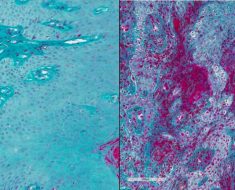High cholesterol: Nutritionist reveals top prevention tips
We use your sign-up to provide content in ways you’ve consented to and to improve our understanding of you. This may include adverts from us and 3rd parties based on our understanding. You can unsubscribe at any time. More info
The circulatory issue usually develops in the legs, blocking blood flow to the feet, which can affect the length of your toenails. When’s the last time you took notice of that area? One telling sign of peripheral artery disease, according to the Mayo Clinic, is “slower growth of your toenails”. The condition can also lead to “painful cramping” in the calf muscles after a bout of activity, such as walking or climbing the stairs.
It’s possible for the leg to become numb, or weak, and for the lower leg and foot to become cold.
Due to a lack of sufficient blood flow, the colour of the lower legs may change too, and it could become shiny in appearance.
This can also lead to hair loss or slower hair growth on the legs and feet.
You’re more likely to develop peripheral artery disease if you:
- Smoke
- Have diabetes
- Are obese
- Have high blood pressure
- Have high cholesterol
- Are over the age of 65
- Have a family history of the condition or stroke.
READ MORE: Fatty liver disease: Signs when you go to the toilet

“People who smoke or have diabetes have the greatest risk of developing peripheral artery disease due to reduced blood flow,” said the experts at the Mayo Clinic.
One of the most effective ways to prevent further health complications is to reduce the progression of fat build-up in the arteries.
This will involve lifestyle changes, which includes being a non-smoker and exercising more.
Medication might be prescribed by your doctor, which can include cholesterol-lowering medication.
A heart-healthy diet can also help to control cholesterol levels.
The British Heart Foundation (BHF) stated: “Everyone should aim for a well balanced diet.”
This includes eating:
- Plenty of fruit and vegetables
- Plenty of starchy foods such as bread, rice, potatoes and pasta – choose Wholegrain varieties wherever possible
- Some milk and dairy products
- Some meat, fish, eggs, beans and other non-dairy sources of protein
- Only a small amount of foods and drinks high in fats and/or sugar
- Choose options that are lower in fat, salt and sugar whenever you can.
It’s also important to “keep within the recommended guidelines” of 14 units weekly if you consume alcohol.

Should you be diagnosed with peripheral artery disease, you need to pay extra attention to your foot care.
The Mayo Clinic pointed out that reduced blood flow can increase the risk of infection.
To look after your feet, it’s important to wash them daily, dry them thoroughly and moisturise often to prevent cracks.
“Don’t moisturise between the toes, however, as this can encourage fungal growth,” the experts said.

Good foot care also includes wearing well-fitting shoes and thick, dry socks.
It’s imperative to treat any fungal infections, such as athlete’s foot, as soon as possible.
Also take care when trimming your nails, inspect the area daily for injuries, and have a “foot doctor” treat bunions, corns or calluses.
Source: Read Full Article





